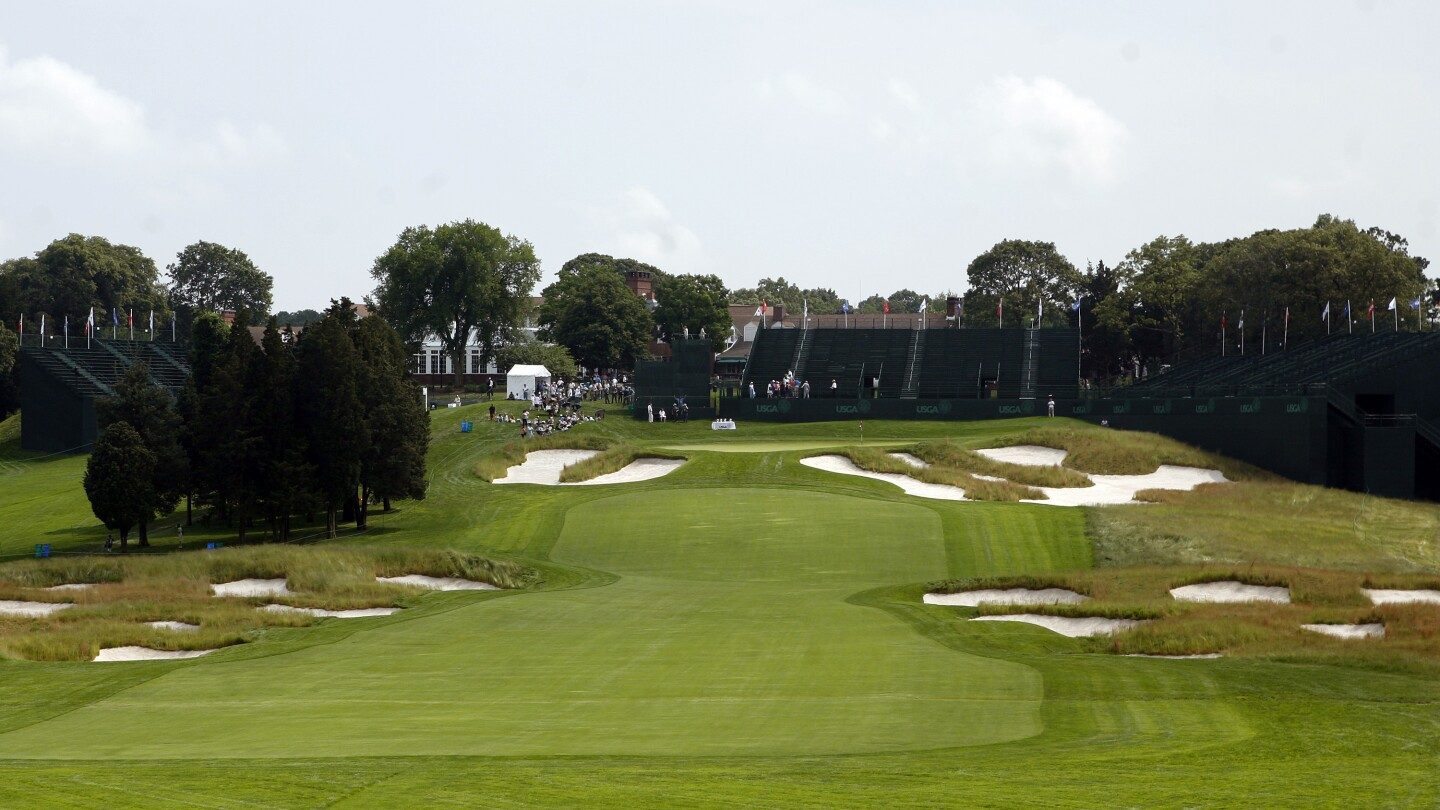FARMINGDALE, NY We present a hole-by-hole analysis of the Black Course at Bethpage State Park, which will host the 45th edition of the Ryder Cup, scheduled for September 26-28: The first shot is from an elevated tee that curves to the right, where a group of trees blocks any approach that tries to take the curve too far. The left side offers a better angle to a green with a bunker on the front right. The front of the green slopes steeply, so any short or over-spinned shot could roll out. This is the smallest green on the course.
No. 1, 397 yards, par 4
The first hole begins from an elevated tee, where the fairway curves to the right. A group of trees on that side punishes any shot that attempts to cut too far into the curve. Playing to the left offers a more favorable angle toward the green, which is defended by a bunker on its front right side. The front third of the green slopes steeply, so short or over-spinning shots tend to roll out. It's also the smallest green on the entire course.
No. 2, 389 yards, par 4
The first two holes are the only par 4s under 400 yards. This hole features a shot from an elevated tee and then a short iron to an elevated green. The fairway curves left between trees on both sides. The left side of the green has a steep drop, while the right side is protected by deep bunkers.
No. 3, 210 yards, par 3
The shallow green slopes from back to front and from left to right, with bunkers on the left so deep that players can only see the top of the flagstick. Any long shot will land severely behind the green.
No. 4, 517 yards, par 5
Although it's short for a par 5, the green sits about 50 feet above the landing area for tee shots. The fairway curves left around a cluster of bunkers. The cross bunkers only come into play if someone runs off the fairway into thick rough. The elevated green is protected by a series of bunkers. The safe play for those trying to reach the green in two is to the right, making chipping easier.
No. 5, 478 yards, par 4
Large cross bunkers hug the right side of the hole, although longer players can easily overcome them. The ideal play is from the right side, as trees cover a ridge on the left. The green is small and well protected by bunkers.
No. 6, 408 yards, par 4
A simple hole with large bunkers that make the fairway seem even narrower. The fairway drops about 20 feet. Using the driver is a risky move to reach the lower part and land a wedge on a small green surrounded by bunkers.
No. 7, 524 yards, par 4
This hole plays as a par 5 during public play. The tee shot is fairly straight before turning right, with tall trees on the right preventing players from taking the curve too far. The approach is a long iron to a green that is not elevated and will allow the ball to roll onto it. A large bunker protects the right side, with a smaller one on the left.
No. 8, 210 yards, par 3
From an elevated tee, the green is protected from the front by a pond, with large bunkers on the left that only come into play for rear pin positions. A tall oak tree and a steep dune lie to the right of the hole. The bank in front of the green is indented, meaning any short shot will likely land in the water. The green has a ridge that can serve as a backstop.
No. 9, 460 yards, par 4
The hole curves to the left with a large bunker complex on the left side of the landing area. Playing short of the bunkers leaves a longer shot from a contoured fairway with a limited view of the green. Two deep bunkers protect the front of a relatively flat green.
No. 10, 502 yards, par 4
This is a straight hole that requires a strong tee shot to reach the fairway. Any shot to the left will encounter high grass, bunkers, or holes. The elevated green is protected by bunkers.
No. 11, 435 yards, par 4
A blind tee shot to a fairway tucked between dunes should favor the right side for a better angle toward the course's most severe green. The putting surface has a false front, which causes problems for any putt or chip from beyond the hole. Bunkers protect the front of the green.
No. 12, 496 yards, par 4
Possibly the most difficult tee shot on the Black Course, players can use the driver over the cross bunkers to shorten the hole, or play safely to the right of the bunkers. Any shot that's too straight could roll off the fairway into the rough. The second shot is easy to a large, severely undulating green.
No. 13, 608 yards, par 5
The longest hole is made slightly easier because it's straight and reachable in two by long players on firm ground. A large bunker on the left is in play from the tee, while the cross bunkers about 30 yards from the green will be a problem for any shot that falls short. The green slopes slightly from back to front, with a bunker on the right that is one of the deepest on the course.
No. 14, 161 yards, par 3
The shortest hole on the course is the only par 3 to play under par at both US Opens. The short iron leads over a valley to a green that slopes from back to front and right to left, with a shelf at the top. Deep bunkers will trap any shot that falls slightly short. This is the second consecutive birdie opportunity before the tricky finish across the road.
No. 15, 477 yards, par 4
The course crosses the road again to a hole that curves left and climbs a steep hill for the final 180 yards to an elevated green protected at the front by deep bunkers. Anyone who goes off the fairway will likely miss the green from the rough, or won't be able to hold it. The green is 50 feet above the fairway and has two levels descending from back left to front right.
No. 16, 490 yards, par 4
The tee shot descends about 60 feet to a narrow fairway that slopes from left to right and can be difficult to hit due to the elevated tee box. The hole curves gently to the left. A large bunker is located short and to the right of the green, with another bunker to the left. This is one of the few holes where the green is visible from the tee.
No. 17, 179 yards, par 3
The slightly elevated green is 43 yards wide and divided by a ridge down the middle, effectively creating two greens. A deep bunker protects the front of the green, while other bunkers trap shots that go right, long, or left.
No. 18, 411 yards, par 4
Among major U.S. championship courses of the past two decades, only the Olympic Club has a shorter closing hole. The tee shot is downhill to a narrow fairway sandwiched between a large cluster of bunkers and fescue on both sides. Players can fall short of the bunkers and have only 160 yards to an elevated green that slopes steeply toward the front.






